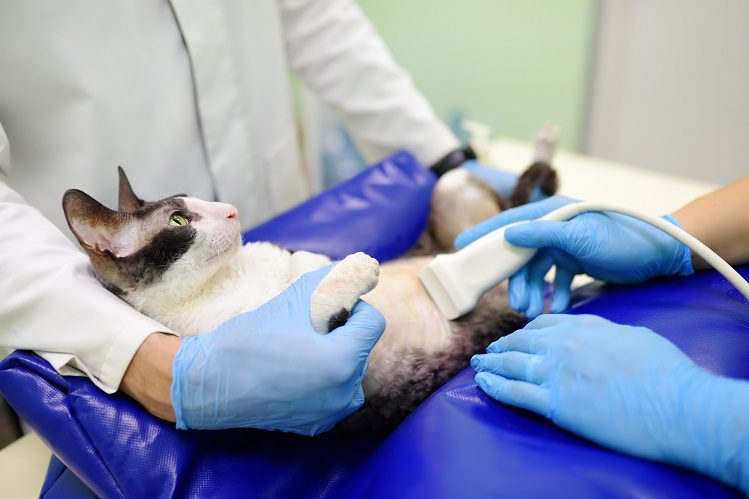
How to suspect urocystitis in a cat and why does it occur?
Boris Vladimirovich Mats, a veterinarian and therapist at the Sputnik clinic, tells.
The urinary system plays an important role in the normal functioning of the entire body of a cat. Any changes in its work can lead to systemic complications and death of the pet.
This article talks about only one group of diseases of the urinary system – urocystitis. Urocystitis is an inflammation of the bladder.
Contents
Symptoms of urocystitis in cats
The main symptoms of urocystitis:
Frequent urge to urinate
Unproductive urination
Blood in urine
Vocalization during urination
Urinating in the wrong places
Urinary retention more than 18-24 hours
Non-specific symptoms: decreased activity and appetite, vomiting, diarrhea, fever, and so on.
It is important to understand that the symptoms described above may not be associated with inflammation of the bladder, but may be signs of other diseases and require the attention of a veterinarian.

Causes of urocystitis in cats
Urocystitis can be caused by:
Stress
bacteria
Crystals and stones
Neoplasms
Iatrogenic causes (Doctor’s actions)
other pathologies.
Let’s look at each reason in more detail. Some of them are related to each other and in combination give symptoms of inflammation of the bladder, some are the only causes in the development of urination disorders.
- Stress
Cats have a disease called idiopathic cystitis. The word “idiopathic” in medicine means that the cause of the disease is not clear. In the case of cats in general, there are many incomprehensible things. However, there are several theories regarding idiopathic cystitis. The most common one says that external factors can cause stress in cats, which provokes the development of cystitis. Since cats are extremely stress-resistant pets, their bladders can become inflamed for literally any reason. The reason, for example, may be the lack of any resources (water, territory, food, communication, etc.), new objects at home, new animals and people, loud noise, bright light, strong smell, and so on and so forth.
Idiopathic cystitis is one of the most common diseases in the group of urocystitis.
This cause of inflammation is diagnosed by studying the history of life and illness, blood and urine tests, ultrasound and x-rays, when all other causes are excluded.
Treatment of idiopathic cystitis consists of symptomatic relief (removal of inflammation, pain relief, and so on) and enrichment of the environment of cats.
- bacteria
Bacteria can enter the bladder and lead to inflammation, then eating the cells of the organ. In cats, this cause of urocystitis is extremely rare and often secondary to idiopathic cystitis or bladder stones.
The final diagnosis is made by a doctor on the basis of a general analysis and bacteriological examination of urine. Other tests will also be required to rule out other pathologies and establish the cause of bacterial cystitis.
The main treatment is antibiotic therapy. Additionally, drugs are prescribed for symptomatic relief and elimination of the root cause.
- Crystals and stones
Due to inappropriate nutrition, insufficient water intake, bacteria and other causes (often unknown at the moment), crystals (sand) and stones from a few millimeters to several centimeters can form in the cat’s bladder.
It is important to understand the type of crystals and stones in the bladder in order to prescribe further treatment. Some of them are dissolved by diet, some cannot be dissolved and surgical removal is necessary. To determine the type of crystals and sediment, a general urine test and a special analysis of stones are used.
The main danger of stones and crystals is that they can cause urethral obstruction. With prolonged urinary retention (more than 1 day), renal failure may develop, and this often leads to the death of the pet.
- Neoplasms
In some cases, the causes of cystitis may be associated with neoplasms in the urinary system. As a rule, such tumors are malignant – and the prognosis may not be very good. Before removing the neoplasm, its cells are examined by a cytologist to determine the type of tumor.
Treatment in this case is exclusively surgical.
- Iatrogenic causes (doctor’s actions)
Urocystitis due to the action of a doctor may occur after catheterization of the bladder and operations. These are frequent complications, even if all the rules for performing manipulations are observed. However, such consequences are not a reason to refuse medical manipulations, since the risk of complications in most cases is lower than the risk of aggravating the cat’s condition with inactivity.
- Other pathologies
Inflammation of the bladder may be secondary to the underlying disease. Most often, urocystitis occurs due to the formation of crystals. For example, with neoplasms in various organs and disorders of the parathyroid gland, calcium oxalates can form. When porto-systemic shunts (pathological vessels) occur, ammonium urates can form.
How is cystitis diagnosed?
Urine research. Urinalysis – allows you to evaluate kidney function, the presence of bacteria, inflammation, blood. Culture of urine bacteria with the determination of antibiotic sensitivity – shows what bacteria are in the urine and what antibiotics will cope with them. This is necessary in order to choose the right antimicrobial treatment.
Ultrasound – gives an understanding of structural changes in the organs of the urinary system, detect stones and “sand” in the bladder, signs of obstruction of the urethra and ureters, suspect a neoplasm, and so on.
X-ray – allows you to visualize stones in the urethra, bladder, ureters and kidneys, suspect a neoplasm, assess the tone and fullness of the bladder.
CT is like an x-ray, only more informative, but requires sedation.
Cystoscopy – using a small camera, the mucous membrane of the urethra and bladder, their contents are visualized. You can also carry out the extraction of stones, install a stent, and so on.
Cytology – used in the diagnosis of neoplasms, allows you to determine their type by cells, to understand the specifics of inflammation.
Histology is the study of bladder tissue. Used in the diagnosis of tumors and inflammation of the bladder of various origins.
Conclusion
Inflammation of the bladder is one of the many causes of improper urination. There are many others, including those not directly related to the urinary system, such as diabetes.
If you notice urinary incontinence in your pet, contact your veterinarian to find the cause and start timely treatment.
Author of the article: Mac Boris Vladimirovich, veterinarian and therapist at the Sputnik clinic.






